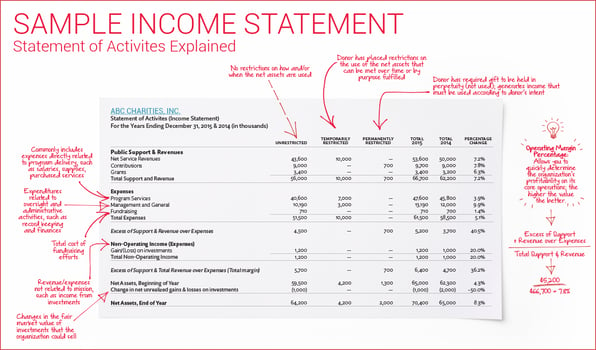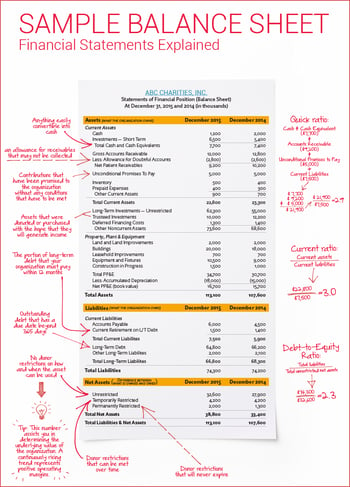If you serve on a nonprofit board, you’ve probably seen those fellow members who look like a deer in the headlights when presented with financial statements. Maybe that’s even you. While everyone is recruited to serve because of a unique skill set, it’s important for all board members to understand the financial statements presented to them.
As best practices and BoardSource tell us, providing oversight is one of the board’s three key roles. This includes maintaining financial accountability of their organizations. Board members are trustees of their organization’s assets and must ensure the organization is well managed. Financial statements show whether this is the case.
This means we as board members should understand those financial statements we’re looking at. We should be looking at internally prepared financial statements at least quarterly, per the Standards for Excellence Institute®, which provides guidance on best practices. We should be reviewing the audit and seeing the IRS Form 990 before it is filed. Is all this happening at your nonprofit? If it’s not, you should be asking some questions.
I was an accounting major in college and am a two-time board treasurer, so accounting doesn’t scare me. I know I’m in the minority here. Part of what can be so intimidating is how nonprofit accounting differs from how we track revenue, expenses, and assets at home.
Some smaller nonprofits use cash basis accounting, which operates like our personal checking accounts. An expense is recognized when it’s paid, regardless of the period the expense covers. This doesn’t present an accurate picture of what’s really going on. Accrual accounting is designed to better match revenue and expenses to give a truer picture of an organization’s financial position. For example, insurance premiums are typically due in advance of the month the insurance covers. Accrual accounting says that the premiums paid in August for September are a prepaid expense and will be on the statement of financial position (nonprofit term for balance sheet) as such until September when they will be recognized as an expense on the statement of activities (nonprofit term for income statement).
Much like there are prepaid expenses, there is deferred revenue—money received before it’s earned. This is often the case with membership organizations that collect dues in advance of the new fiscal year. The money is in the bank account, but the memberships aren’t activated yet. When the money is earned, say in this case the new fiscal year, the revenue is recognized.
Another tricky concept is depreciation. In our personal lives we tend to think of depreciation as what happens as our cars get older. In accrual accounting, depreciation is allocating the cost of a capital purchase (think computers, furniture, a new roof—most expensive physical or technological purchases) over its useful life. Your accountant will help you determine the useful life, and it’s really about accounting versus how long the item will actually last. Say, for example, you bought $9,000 worth of computers. That means $9,000 leaves your bank account and you have new computers. Because of depreciation, though, you will not recognize all $9,000 as an expense that year. Instead, the expense will be spread over the computers’ useful lives, say three years. Depreciation expense is shown on your statement of activities and accumulated depreciation is shown on your statement of financial position. Then there is the third, and often neglected, financial statement called the statement of cash flows. This is where you can actually see how the organization’s cash was used in a given year. This is a very useful financial statement for most organizations that use accrual accounting, as it gives a detailed picture of cash activity for the time period presented.
 Depreciation can cause confusion in a few different ways. Not all nonprofits are in the practice of “booking” depreciation monthly to present an accurate picture of revenue minus expenses on the statement of activities. This can lead to a big surprise come the end-of-year audited financial statements when it’s included. One volunteer-run organization I know didn’t account for depreciation until the end of the year and went from a positive change in net assets (profit) to a negative change in net assets (loss) because of a significant depreciation expense related to significant purchases and renovations made during a recent capital campaign. That was a big shock that didn’t need to happen.
Depreciation can cause confusion in a few different ways. Not all nonprofits are in the practice of “booking” depreciation monthly to present an accurate picture of revenue minus expenses on the statement of activities. This can lead to a big surprise come the end-of-year audited financial statements when it’s included. One volunteer-run organization I know didn’t account for depreciation until the end of the year and went from a positive change in net assets (profit) to a negative change in net assets (loss) because of a significant depreciation expense related to significant purchases and renovations made during a recent capital campaign. That was a big shock that didn’t need to happen.
Another item that can cause confusion and often cause a flip between a positive or negative change in net assets or vice versa on a statement of activities is unrealized gains or losses, which result from adjusting investments to market value at a point of time. Generally Accepted Accounting Principles (GAAP) require that these gains or losses on investments be included on any audited statement of activities. This is a challenge because how can you budget for what the market will do? It’s also different than how we as individuals only recognize realized gains as income. If you happen to try to reconcile an organization’s financial statements with its IRS Form 990, there can be even more confusion as unrealized gains and losses are not included as income or loss on the IRS Form 990.
Many nonprofit organizations accept pledges, which we’ll define here as unconditional promises to pay a donation over time. While the development department records a pledge as such and applies payments toward the pledge as received, GAAP dictates that pledges be booked as revenue when the pledge is made for accounting purposes. To make matters even more confusing, then there is a reduction for doubtful accounts that your accountant will help you come up with very much like for accounts receivable. After all, not everyone makes good on their pledges.
The statement of financial position reports the assets, liabilities, and what’s left over after liabilities are subtracted from assets—net assets—as of a set point in time be it the end of a month, quarter or year.. When looking at assets it’s important to notice what assets are current, those that can easily be converted to cash, versus those that are physical assets (property, buildings, equipment) and are not as easily used for monthly bills. Net assets are also important to understand because they can come with restrictions. Temporarily restricted net assets are those that have either a restriction of time or purpose for which they can be used. Think of a grant designated for a specific program for a one-year period. Other net assets are permanently restricted, such as an endowment, where only income or a specified amount of principle can possibly be used.
I once worked for a $8MM year nonprofit that relied heavily on government contracts versus fundraising. The organization had millions of dollars in assets if you included its headquarters, fleet of vehicles, and all the furniture and computers. At one board meeting, a board member looked at the statement of financial position and commented how financially healthy the organization was. He neglected to notice that the cash balance was less than $50,000 and investments were only $70,000. This was an organization that was highly illiquid and often relied on a line of credit to meet payroll when government payments were delayed. This is an example of the usefulness of the statement of cash flows as it would indicate how little liquid assets the organization had as compared to the revenue or net assets.
Now that you have a grasp of the trickier nonprofit accounting concepts, where can you go learn more? A great resource is Understanding Nonprofit Financial Statements, Third Edition, by Steven Berger, CPA. Another helpful resource is your organization’s auditor. Most are happy to attend board meetings and go in-depth explaining the financial statements in the audit as well as the accompanying notes. Most importantly, don’t be afraid to ask questions. More than likely, someone else at the board table is wondering the same thing you are.
Based in Wilmington, DE Stephanie Cory, CFRE, CAP is a Certified Governance Trainer through BoardSource. She is a frequent speaker on a variety of nonprofit topics and has served as a program director, development director, executive director, and consultant.


